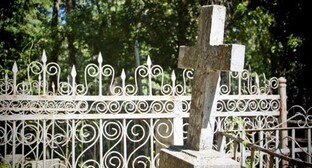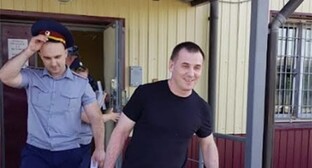07 May 2003, 04:27
Kislovodsk
City in Stavropol kray (region), kray subordination, 234 km south-east of Stavropol, balneal and climatic health resort of All-Russian significance, in the group of health resorts of Caucasian Mineral Waters. Located on the northern foothills of the Greater Caucasus, at the height of 800-1,200 m, in valleys of the Olkhovka and Berezovaya Rivers (tributaries of the Podkumok River); on the stair-step levels of terrains of the Dzhinal Ridge. The climate is continental. Winter is moderately mild, dry, with an unsteady snow cover; the temperature in January averages to -4?С (sometimes going down to -20?С, -30?С and up to 18-19?С at thaws). Spring is early, short, with moderate breezes. Summer is warm, continuous (more than 5 months); July-August temperature averages to 19?C; sometimes, the weather is hot and dry. Daily variations of temperature are considerable, and even in the hottest days, evenings and nights are cool. Autumn is mostly sunny, first frosty days take place as early as in October. Precipitations of about 600 mm a year, primarily in spring and summer.
Terminal station of the railway branch (64 km) from Mineralny Vody. Population (1992 est.) 118 thousand, (1897 est.) about 2.5 thousand, (1926 est.) 22 thousand, (1939 est.) 51 thousand, (1959 est.) 78 thousand, (1970 est.) 90 thousand.
The name of the health resort city is derived from the Turkic for acidic waters, ache-su, due to presence of some springs of acidic water in the area of the city. The name of the Narzan spring is derived from the Kabardian for Hercules water, nartsanna. Investigation of Kislovodsk narzans began as early as in the late 18th century (Y. Reynegs, 1784; academician P.S. Pallas, 1793; etc.). In 1798, the first group of patients (the commander of infantry units in the Caucasus, Lieutenant General I. Markov and his attendants, totalling to more than a thousand, were treated here; in the same year, a fortification and a hospital were designed. 1803, when the Kislovodsk fortification was built (the special decree by Emperor Aleksandr I declared Kislovodsk to be a medical area) is considered to be the health resort foundation year, though actually the first official arrival of patients was only in 1808-1809 because of the 1804-1808 plague epidemic in the Caucasus. The health resort was raided by mountaineers quite often in its first years. Therefore, a small fortress was erected to protect the patients, and there was a series of redoubts and posts in the environs. 1812 and 1820 saw construction of the first wooden swimming baths and the wooden narzan well (the so-called Myasnikovsky log-house) respectively. In 1822, a restoration with a colonnade and a broad staircase going down into the park, was built from the design by the architects Bernardacci brothers (though, it did not last until now); there was a grotto under it. In 1823, a state hotel started to be built near the springs, and the resort park was laid out. In the first half of the 19th century, main residents in the sloboda (settlement) of Kislovodsk were retired and married soldiers, Terek Cossacks settling in the area of the Berezovaya and Olkhovka gully. Town since 1830. In 1851, a plot for construction of resort establishments was selected within the area of Kislovodsk. During the 19th century, water-catchment from the spring of Narzan was fitted out. Kislovodsk experienced revitalising of resort construction and afflux of patients in the late 19th century. They were stipulated by completion of construction of the Mineralny Vody - Kislovodsk highway and especially by driving of a railway branch to the city (1893). 1896 saw opening of a mineral water bottling factory. In 1895, the administration of the Vladikavkaz railway built Bely Ugol, one of the first Russian hydroelectric stations, on the Podkumok River (between Kislovodsk and Yessentuki), which provided Kislovodsk with electricity. In the early 20th century, Kislovodsk saw intensive private construction (summer residences, boarding houses, hotels). In 1904, more than 25 thousand patients were treated here. During World War I (1914-1918), the health resort functioned as a hospital for wounded soldiers and disabled veterans.
In the 1920-1930s, Kislovodsk built new sanatorium buildings, resort polyclinics, therapeutic mud baths; hydro-geological surveys were also made. In addition to the spring of Narzan, there are six more springs whose waters are open to daylight; they include dolomite narzan (1928) and sulphate narzan (1934). In the second half of the 1940s, Kislovodsk restored its resort facilities, which were heavily destroyed during Nazi occupation (from August 10, 1942 to January 10, 1943). In 1950, the health resort took 125 thousand patients for treatment.
Kislovodsk health resort welcomed A.S. Pushkin, М.I. Glinka, M.Y. Lermontov, F.I. Shalyapin, L.V. Sobinov etc., who had a rest and were treated here at different times. Since 1892, Kislovodsk was the permanent residence of the artist N.A. Yaroshenko. Kislovodsk was closely linked with life and creativity of the Russian pianist and musical figure V.I. Safonov (1852-1918).
Present Kislovodsk is the largest in the group of health resorts of the Caucasian Mineral Waters: about 240 thousand people are treated here every year. In 1991, health resorts of Kislovodsk had 29 sanatoriums and 14 boarding houses (possessing about 15 thousand beds altogether), the number of patients who had a rest and treatment totalling to 276.6 thousand. Medical establishments shared by all the resorts are the Narzan gallery, 2 well-rooms feeding cold and heated mineral water, the Glavny narzan baths, the Octyabrsky narzan baths, a physiotherapeutic and balneal house, a therapeutic mud baths (at the Krepost sanatorium), a resort polyclinic with branches, a radiological centre, a cardiological clinic (a branch of Pyatigorsk Institute of Balneology and Physiotherapy). There is the Velingrad boarding house on a side of a man-made lake.
The main natural medical factors are mineral springs, Kislovodsk narzans. Waters of the 7 springs functioning in Kislovodsk are carbonic calcium-magnesium sulphate-hydrocarbonate. Mineralisation of water from the spring of Narzan, which laid the foundations of the health resort, is over 1.8 g/l; it contains more than 1 g/l carbonic acid, water temperature being about 12?С; and is mostly used for baths. Water of the Dolomite narzan spring comes from the depth of about 65 m, is heavily mineralised (3.4 g/l) and has a higher content of carbon dioxide (2 g/l). The sulphate narzan comes from the depth of about 170 m, its mineralisation is more than 5 g/l, and contents of carbonic acid is about 2 g/l. The dolomite and sulphate narzans are used for peroral treatment. Other springs of narzans are boreholes of various depth, and their waters are used for baths. The water-pipe of about 43 km long provides Kislovodsk with carbonic waters (narzans) from Karachay-Cherkessia (the settlement of Krasny Vostok), as well as from Kuma deposit. Alongside with baths and peroral treatment, Kislovodsk narzans are used for inhalations, irrigations, lavages, etc.
In addition to climatic and balneotherapy, Kislovodsk provides its patients with sulphide silt mud of Tambukan lake (6.5 km south-east of Pyatigorsk). Fangotherapy is carried out in the therapeutic mud bath shared by all the resorts. Other treatment includes terrain Kuhr (overall length of routes is about 30 km), therapeutic physical training, physiotherapy. The healing park is equipped with outdoor and indoor swimming-pools. Medical establishments of Kislovodsk specialise in treatment of cardiological patients. In addition, patients (including children and teenagers) with diseases of respiration organs (of untubercular nature), the nervous system, violations of metabolism accompanying diseases of digestion organs are also treated here.
Kislovodsk has flavouring industry (including the Narzan mineral water bottlery), light and furniture industries. Theatres (including 2 summer ones). Concert hall. Philharmonic society. Museum of local-lore, museum of history of the health resort, art museum of N.A. Yaroshenko (in the Belaya villa, the house of the artist), musical and theatrical culture museum, historical and cultural museum of Dacha F.I. Shalyapina, museum of cosmonautics, constant exhibition of the history of the health resort. The resort park is equipped with a cable road, its upper station adjoining the sport complex of Olymp including a stadium, a swimming-pool and a hotel).
Architectural monuments in the central part of the city include the Narzan gallery in the style of Gothic Revival (1848-1858, architect S.P. Upton), Poplar Alley with buildings of the Glavny narzan baths (eclectic Indo-Moresque style, 1901-1904, architect A.N. Klepinin) and the Octyabrsky baths (constructivism, 1928, architect P.P. Yeskov), the former Grand Hotel (1903, the present resort polyclinic), etc.
In the south-west part of Kislovodsk, in the former Soldatskaya sloboda (settlement), there are fragments of a fortress (1803), regular residential building-up of the second half of the 19th and the early 20th centuries. To the east of the Poplar Alley, there is a complex of the Kursaal (neo-Renaissance, Art Nouveau, 1895) and the sanatorium and health resort area, which was built up most in the 1920s, including building up under the general city-planning scheme of 1934 (architect V.N. Semyonov, etc.): sanatoriums of Desyat let Oktyabrya (constructivism, 1928-1931, architect I.A. Fomin), S. Ordzhonikidze (constructivism, 1935-1937, architect M.Y. Ginzburg, I.I. Leonidov, etc.), Rossiya (1936, architect P.P. Yeskov), Piket (1971, architect S.D. Turchaninov), etc. West and north-east districts of the city (the multi-storeyed Kavkaz Hotel, the Krugozor boarding house, the sanatorium of Moskva, etc.) were built under the 1968 Kislovodsk general development plan. The parks occupy more than 2 thousand hectares. They include the Kurortny part in the south-west of Kislovodsk with the lower part laid out in the 1840s to the south of the Narzan gallery, the middle one laid out in 1902 and the upper one developed since 1946.
Kislovodsk and its environs have a lot of natural sights, including the Krasnye (Red), Serye (Grey) and Sinye (Blue) stones, representing queerly winded rocks of sandstone, including the Koltso-hill (Ring-hill). One can enjoy foot walks round Lermontov sights (including the Lermontov rock, which might have been described by the poet in his novel Geroy nashego vremeni (A Hero of Our Time) as the place of Pechorin's duel), mountains of Maloye and Bolshoye Sedlo, gorges of the rivers of Alikonovka (with Medovye water-falls), Beryozovka, Olkhovka (with Lermontov water-fall), excursion trips to Dolina narzanov (the Valley of narzans), to Mount Bermamyt (with a view of mountains of the Greater Caucasus, including Elbrus), Golubye lakes, Chegem and Baksan gorges, Arkhyz, Teberda, Dombay, etc.




